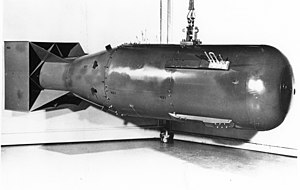| Little Boy | |
|---|---|
 A post-war Little Boy model | |
| Type | Nuclear weapon |
| Place of origin | United States |
| Production history | |
| Designer | Los Alamos Laboratory |
| Manufacturer |
|
| Produced | 1945–1947 |
| No. built | 1 wartime + 5 postwar |
| Specifications | |
| Mass | 9,700 pounds (4,400 kg) |
| Length | 10 feet (3.0 m) |
| Diameter | 28 inches (71 cm) |
| Filling | Highly enriched uranium |
| Filling weight | 64 kg (141 lb) |
| Blast yield | 15 kilotons of TNT (63 TJ) |
Little Boy is the name of the type of atomic bomb used in the bombing of the Japanese city of Hiroshima on 6 August 1945 during World War II, making it the first nuclear weapon used in warfare. The bomb was dropped from the Boeing B-29 Superfortress Enola Gay piloted by Colonel Paul W. Tibbets Jr., commander of the 509th Composite Group, and Captain Robert A. Lewis. It exploded with an energy of approximately 15 kilotons of TNT (63 TJ) and had an explosion radius of approximately 1.3 kilometers which caused widespread death across the city. The Hiroshima bombing was the second nuclear explosion in history, after the Trinity nuclear test.
Little Boy was developed by Lieutenant Commander Francis Birch's group at the Manhattan Project's Los Alamos Laboratory during World War II, a reworking of their abandoned Thin Man nuclear bomb. Like Thin Man, it was a gun-type fission weapon. It derived its explosive power from the nuclear fission of uranium-235, whereas Thin Man was based on fission of plutonium-239. Fission was accomplished by shooting a hollow cylinder (the "bullet") onto a solid cylinder of the same material (the "target") by means of a charge of nitrocellulose propellant powder. Little Boy contained 64 kilograms (141 lb) of highly enriched uranium, although less than a kilogram underwent nuclear fission. Its components were fabricated at three different plants so that no one would have a copy of the complete design. Unlike the implosion design, which required sophisticated coordination of shaped explosive charges, the gun-type design was considered almost certain to work so it was never tested before its first use at Hiroshima.
After the war, numerous components for additional Little Boy bombs were built. By 1950, five complete weapons had been created, and these were retired by November 1950.